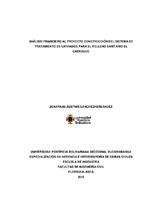Mostrar el registro sencillo del ítem
Análisis financiero al proyecto construcción del sistema de tratamiento de lixmados para el relleno sanitario el carrasco
| dc.contributor.advisor | Castillo Meza, Luis Eduardo | |
| dc.contributor.author | Sánchez Hernández, Jonathan Austhin | |
| dc.coverage.spatial | Seccional Bucaramanga. Universidad Pontificia Bolivariana. Escuela de Ingenierías. Facultad de Especialización en Gerencia e Interventoría de Obras Civiles | spa |
| dc.coverage.temporal | 2012 | |
| dc.date.accessioned | 2015-01-27T16:25:52Z | |
| dc.date.available | 2015-01-27T16:25:52Z | |
| dc.date.created | 2013-05-07 | |
| dc.date.issued | 2015-01-27 | |
| dc.identifier.uri | http://hdl.handle.net/20.500.11912/2058 | |
| dc.description | 65p.: (pdf); il; gráficas; tablas | spa |
| dc.description.abstract | Dado que el control de la contaminación ambiental es prioritario, y se busca en primer término, evitar los daños al medio ambiente, y si estos ocurrieran, en segunda instancia restaurar el entorno; la construcción del sistema de tratamiento de lixiviado para el Relleno Sanitario El Carrasco cobra especial importancia tanto desde el punto de vista financiero como ambiental. Desde esta perspectiva, el investigador propone efectuar el análisis financiero al proyecto construcción de la segunda etapa de la optimización del sistema de tratamiento de lixiviado para el relleno sanitario el carrasco, con base en el cobro por concepto de tasa retributiva por los vertimientos puntuales realizados al cuerpo de agua de la quebrada la iglesia. Para tal efecto se efectúa el análisis de la disposición de residuos sólidos y a partir de ella la generación de lixiviados con su correspondiente caracterización, tanto en el área rellenada como en la cantidad de infiltración permitida y en el sistema de receje e impermeabilización. Posteriormente se contextualiza la generación de lixiviados con el análisis del Relleno Sanitario El Carrasco en sus tres cárcavas, así como la normatividad legal que regula tanto la disposición final de residuos sólidos como el control de lixiviados. El segundo capítulo de la investigación está compuesto por la descripción del proyecto en cuanto a antecedentes, sistema de tratamiento, situación actual de la planta de tratamiento de lixiviados, y diseño del sistema en la segunda etapa. Teniendo en cuenta que el objetivo general del estudio está destinado al análisis financiero del sistema de tratamiento, el tercer capítulo contempla el análisis de la situación actual que le acarrea sanciones por incumplimiento en la cota de remoción (por debajo del 80%) y cobros de tasa retributiva que durante los años 2009 y 2010 alcanzaron los $41.876.294 pesos. | spa |
| dc.description.abstract | Since the control of environmental pollution is a priority, looking in the first place without causing damage if they occur, trying on appeal to restore the environment, construction of leachate treatment system for the El Carrasco Landfill is particularly important both from the standpoint of financial and environmental. From this perspective, the researcher intends to make the construction project financial analysis of the second stage of optimization of leachate treatment system for the landfill, based on the collection by way of repayment fee for dumping point made the body of water from the broken church To this effect are taken for analysis of solid waste disposal and from this generation with the corresponding leachates characterization, both in the filled area and the amount of infiltration and allowed recaje and waterproofing system Later leachate generation contextualizes the analysis of El Carrasco Landfill in three gullies, and the legal norms that regulates the disposal of solid waste and leachate control The second strand of research is composed of description in terms of background, treatment system, current status of leachate treatment plant and system design in the second stage Given that the overall objective of the study is aimed at financial analysis of the treatment system, The third chapter looks at the current situation analysis which carries penalties for failure to coordinate removal (below 80%) and repayment fee charges that during the years 2009 and 2010 amounted to $ 41,876,294 This situation forces the company to invest in the second phase of the leachate treatment plant requiring an investment of $ 919,214,957.31 and although the horizon of the project shows that it is a risky investment for the recovery of expenses, opportunity costs compensate for this situation as risk management of 12 pollution by dumping generated, supporting the importance of investment in reducing pollutants in water sources First with regard to the Church Creek is located on the front pages of contamination and subsequent flows into the Rio de Oro and the second factor to consider with the decrease of vectors are generated because of water sources contaminated leachate that do not reach an acceptable level of removal by failing to comply with the standards established and making its mark as an entity that is not friendly to the environment and not as a company generates a self-sustaining security and internally regulated | |
| dc.language.iso | es | |
| dc.publisher | Universidad Pontificia Bolivariana | spa |
| dc.rights | Attribution-NonCommercial-NoDerivatives 4.0 International | * |
| dc.rights.uri | http://creativecommons.org/licenses/by-nc-nd/4.0/ | * |
| dc.subject | Tesis y disertaciones académicas | spa |
| dc.subject | Proyectos de construcción | spa |
| dc.subject | Rellenos sanitarios | spa |
| dc.subject | Carrasco | spa |
| dc.subject | Medio ambiente | spa |
| dc.subject | Construcción | spa |
| dc.subject | Residuos sólidos | spa |
| dc.title | Análisis financiero al proyecto construcción del sistema de tratamiento de lixmados para el relleno sanitario el carrasco | spa |
| dc.type | book | spa |
| dc.rights.accessRights | openAccess | spa |
| dc.type.hasVersion | publishedVersion | spa |
| dc.identifier.instname | instname:Universidad Pontificia Bolivariana | spa |
| dc.identifier.reponame | reponame:Repositorio Institucional de la Universidad Pontificia Bolivariana | spa |
| dc.identifier.repourl | repourl:https://repository.unab.edu.co/ |
Ficheros en el ítem
Este ítem aparece en la(s) siguiente(s) colección(ones)
-
Trabajos de grado [6348]
Monografías, artículos, informes, proyecto de grado


